Food and Beverage Operations Management Report: Systems Analysis
VerifiedAdded on 2020/05/16
|12
|3826
|78
Report
AI Summary
This report delves into the intricacies of food and beverage operations management, examining various aspects from food production methods to menu design and cost implications. It begins by outlining the characteristics of different food production and beverage service systems, including table service, buffet, and specialized services. The report then explores factors influencing recipes and menus, such as customer needs, resource availability, and budget constraints, while also considering the impact of kitchen space and equipment. Furthermore, it compares the cost and staffing implications of different food service systems, highlighting the financial and operational considerations for each. Finally, the report justifies the suitability of specific systems for various food and beverage outlets, providing a comprehensive overview of the subject matter. The report emphasizes the role of a management trainee in the hospitality industry, focusing on customer satisfaction, beverage stocking, and the importance of continuous improvement through performance evaluations and training.
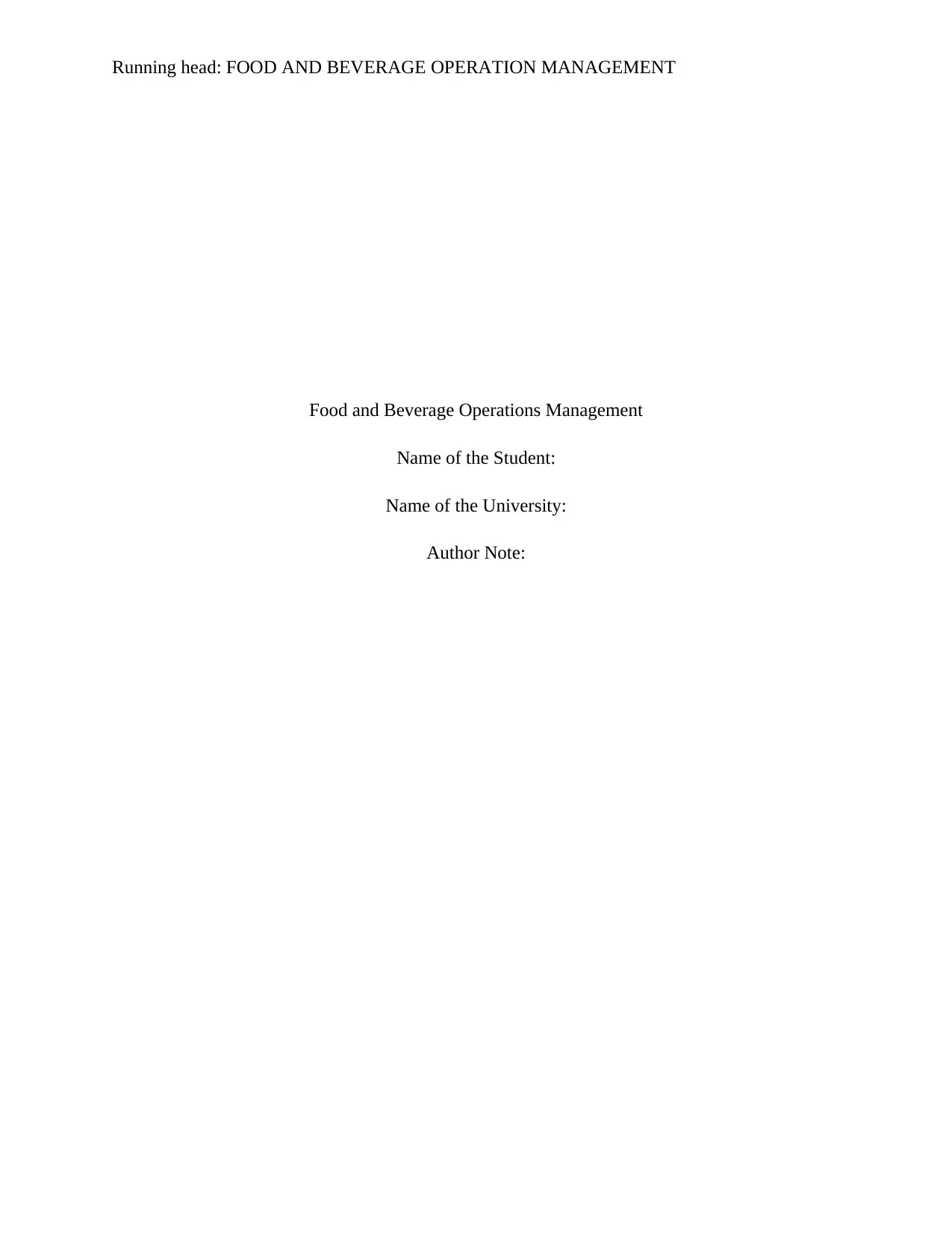
Running head: FOOD AND BEVERAGE OPERATION MANAGEMENT
Food and Beverage Operations Management
Name of the Student:
Name of the University:
Author Note:
Food and Beverage Operations Management
Name of the Student:
Name of the University:
Author Note:
Paraphrase This Document
Need a fresh take? Get an instant paraphrase of this document with our AI Paraphraser
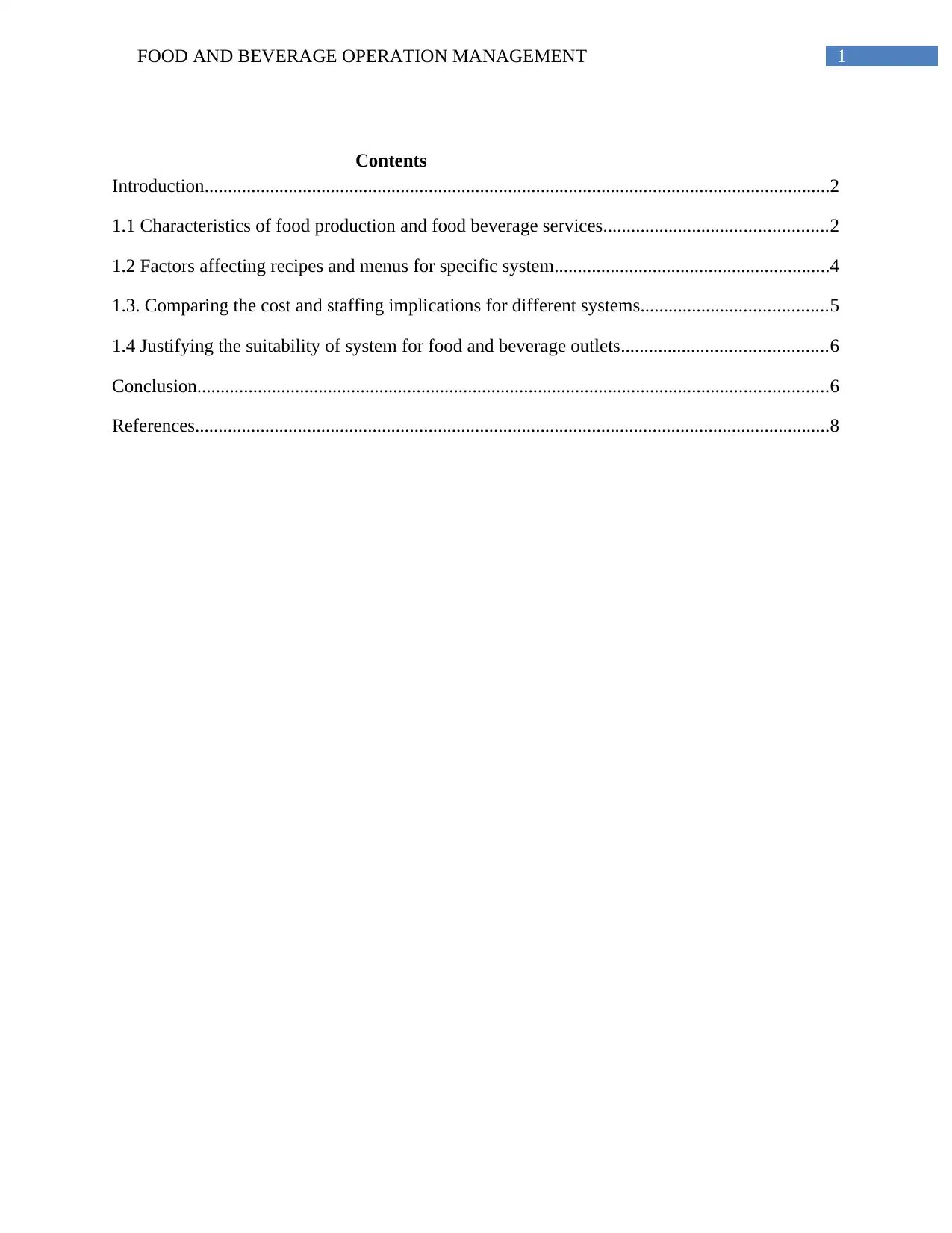
1FOOD AND BEVERAGE OPERATION MANAGEMENT
Contents
Introduction......................................................................................................................................2
1.1 Characteristics of food production and food beverage services................................................2
1.2 Factors affecting recipes and menus for specific system...........................................................4
1.3. Comparing the cost and staffing implications for different systems........................................5
1.4 Justifying the suitability of system for food and beverage outlets............................................6
Conclusion.......................................................................................................................................6
References........................................................................................................................................8
Contents
Introduction......................................................................................................................................2
1.1 Characteristics of food production and food beverage services................................................2
1.2 Factors affecting recipes and menus for specific system...........................................................4
1.3. Comparing the cost and staffing implications for different systems........................................5
1.4 Justifying the suitability of system for food and beverage outlets............................................6
Conclusion.......................................................................................................................................6
References........................................................................................................................................8
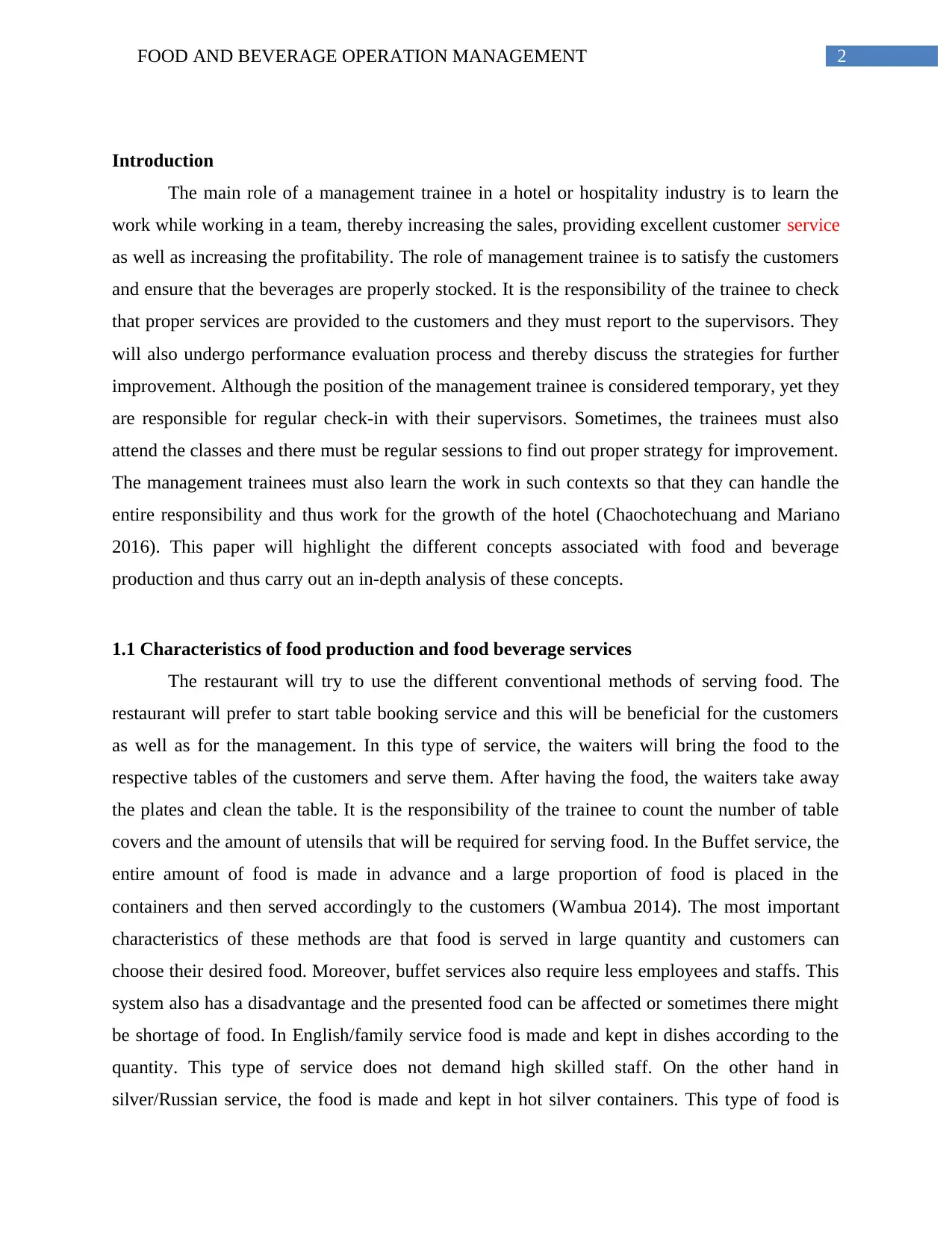
2FOOD AND BEVERAGE OPERATION MANAGEMENT
Introduction
The main role of a management trainee in a hotel or hospitality industry is to learn the
work while working in a team, thereby increasing the sales, providing excellent customer service
as well as increasing the profitability. The role of management trainee is to satisfy the customers
and ensure that the beverages are properly stocked. It is the responsibility of the trainee to check
that proper services are provided to the customers and they must report to the supervisors. They
will also undergo performance evaluation process and thereby discuss the strategies for further
improvement. Although the position of the management trainee is considered temporary, yet they
are responsible for regular check-in with their supervisors. Sometimes, the trainees must also
attend the classes and there must be regular sessions to find out proper strategy for improvement.
The management trainees must also learn the work in such contexts so that they can handle the
entire responsibility and thus work for the growth of the hotel (Chaochotechuang and Mariano
2016). This paper will highlight the different concepts associated with food and beverage
production and thus carry out an in-depth analysis of these concepts.
1.1 Characteristics of food production and food beverage services
The restaurant will try to use the different conventional methods of serving food. The
restaurant will prefer to start table booking service and this will be beneficial for the customers
as well as for the management. In this type of service, the waiters will bring the food to the
respective tables of the customers and serve them. After having the food, the waiters take away
the plates and clean the table. It is the responsibility of the trainee to count the number of table
covers and the amount of utensils that will be required for serving food. In the Buffet service, the
entire amount of food is made in advance and a large proportion of food is placed in the
containers and then served accordingly to the customers (Wambua 2014). The most important
characteristics of these methods are that food is served in large quantity and customers can
choose their desired food. Moreover, buffet services also require less employees and staffs. This
system also has a disadvantage and the presented food can be affected or sometimes there might
be shortage of food. In English/family service food is made and kept in dishes according to the
quantity. This type of service does not demand high skilled staff. On the other hand in
silver/Russian service, the food is made and kept in hot silver containers. This type of food is
Introduction
The main role of a management trainee in a hotel or hospitality industry is to learn the
work while working in a team, thereby increasing the sales, providing excellent customer service
as well as increasing the profitability. The role of management trainee is to satisfy the customers
and ensure that the beverages are properly stocked. It is the responsibility of the trainee to check
that proper services are provided to the customers and they must report to the supervisors. They
will also undergo performance evaluation process and thereby discuss the strategies for further
improvement. Although the position of the management trainee is considered temporary, yet they
are responsible for regular check-in with their supervisors. Sometimes, the trainees must also
attend the classes and there must be regular sessions to find out proper strategy for improvement.
The management trainees must also learn the work in such contexts so that they can handle the
entire responsibility and thus work for the growth of the hotel (Chaochotechuang and Mariano
2016). This paper will highlight the different concepts associated with food and beverage
production and thus carry out an in-depth analysis of these concepts.
1.1 Characteristics of food production and food beverage services
The restaurant will try to use the different conventional methods of serving food. The
restaurant will prefer to start table booking service and this will be beneficial for the customers
as well as for the management. In this type of service, the waiters will bring the food to the
respective tables of the customers and serve them. After having the food, the waiters take away
the plates and clean the table. It is the responsibility of the trainee to count the number of table
covers and the amount of utensils that will be required for serving food. In the Buffet service, the
entire amount of food is made in advance and a large proportion of food is placed in the
containers and then served accordingly to the customers (Wambua 2014). The most important
characteristics of these methods are that food is served in large quantity and customers can
choose their desired food. Moreover, buffet services also require less employees and staffs. This
system also has a disadvantage and the presented food can be affected or sometimes there might
be shortage of food. In English/family service food is made and kept in dishes according to the
quantity. This type of service does not demand high skilled staff. On the other hand in
silver/Russian service, the food is made and kept in hot silver containers. This type of food is
⊘ This is a preview!⊘
Do you want full access?
Subscribe today to unlock all pages.

Trusted by 1+ million students worldwide
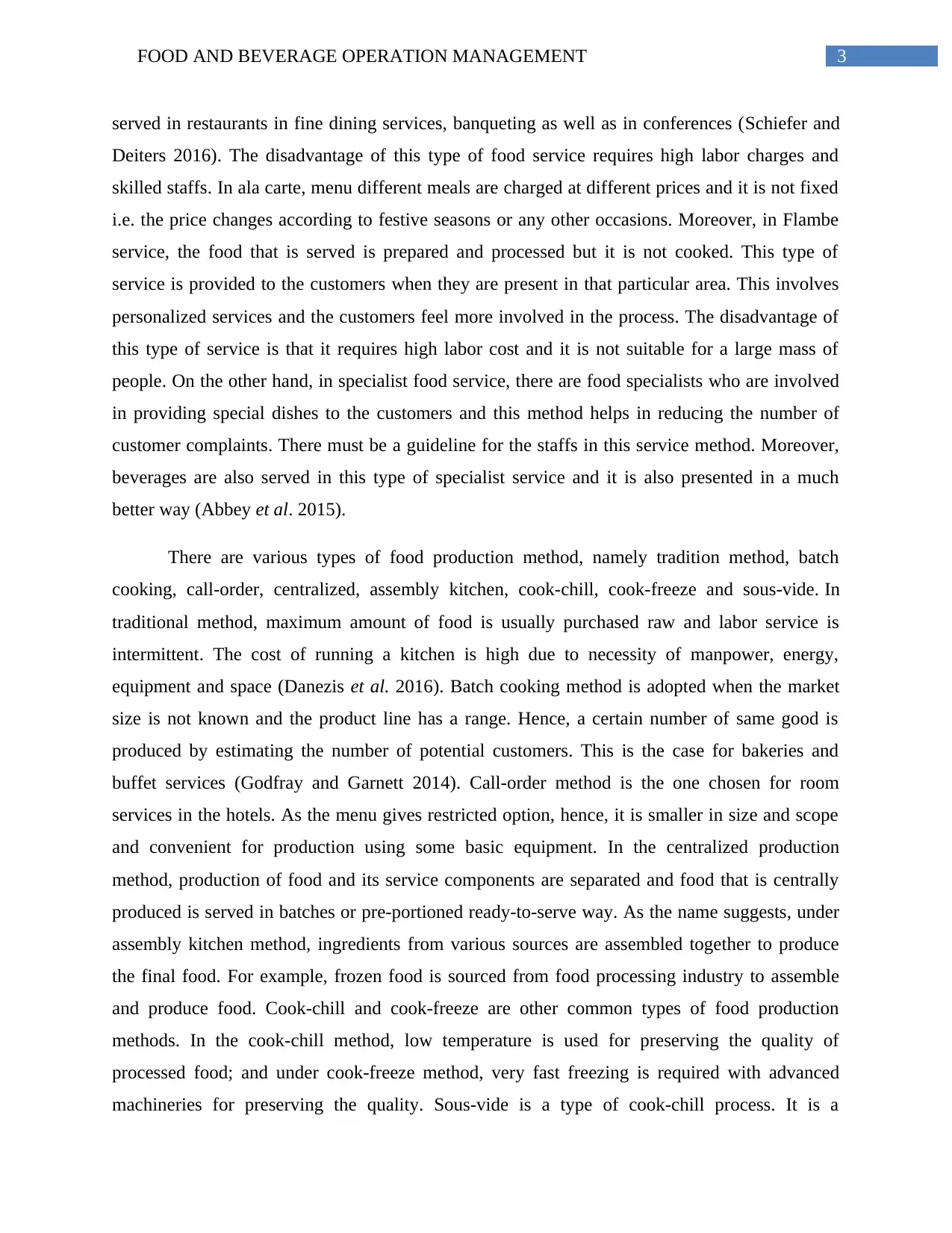
3FOOD AND BEVERAGE OPERATION MANAGEMENT
served in restaurants in fine dining services, banqueting as well as in conferences (Schiefer and
Deiters 2016). The disadvantage of this type of food service requires high labor charges and
skilled staffs. In ala carte, menu different meals are charged at different prices and it is not fixed
i.e. the price changes according to festive seasons or any other occasions. Moreover, in Flambe
service, the food that is served is prepared and processed but it is not cooked. This type of
service is provided to the customers when they are present in that particular area. This involves
personalized services and the customers feel more involved in the process. The disadvantage of
this type of service is that it requires high labor cost and it is not suitable for a large mass of
people. On the other hand, in specialist food service, there are food specialists who are involved
in providing special dishes to the customers and this method helps in reducing the number of
customer complaints. There must be a guideline for the staffs in this service method. Moreover,
beverages are also served in this type of specialist service and it is also presented in a much
better way (Abbey et al. 2015).
There are various types of food production method, namely tradition method, batch
cooking, call-order, centralized, assembly kitchen, cook-chill, cook-freeze and sous-vide. In
traditional method, maximum amount of food is usually purchased raw and labor service is
intermittent. The cost of running a kitchen is high due to necessity of manpower, energy,
equipment and space (Danezis et al. 2016). Batch cooking method is adopted when the market
size is not known and the product line has a range. Hence, a certain number of same good is
produced by estimating the number of potential customers. This is the case for bakeries and
buffet services (Godfray and Garnett 2014). Call-order method is the one chosen for room
services in the hotels. As the menu gives restricted option, hence, it is smaller in size and scope
and convenient for production using some basic equipment. In the centralized production
method, production of food and its service components are separated and food that is centrally
produced is served in batches or pre-portioned ready-to-serve way. As the name suggests, under
assembly kitchen method, ingredients from various sources are assembled together to produce
the final food. For example, frozen food is sourced from food processing industry to assemble
and produce food. Cook-chill and cook-freeze are other common types of food production
methods. In the cook-chill method, low temperature is used for preserving the quality of
processed food; and under cook-freeze method, very fast freezing is required with advanced
machineries for preserving the quality. Sous-vide is a type of cook-chill process. It is a
served in restaurants in fine dining services, banqueting as well as in conferences (Schiefer and
Deiters 2016). The disadvantage of this type of food service requires high labor charges and
skilled staffs. In ala carte, menu different meals are charged at different prices and it is not fixed
i.e. the price changes according to festive seasons or any other occasions. Moreover, in Flambe
service, the food that is served is prepared and processed but it is not cooked. This type of
service is provided to the customers when they are present in that particular area. This involves
personalized services and the customers feel more involved in the process. The disadvantage of
this type of service is that it requires high labor cost and it is not suitable for a large mass of
people. On the other hand, in specialist food service, there are food specialists who are involved
in providing special dishes to the customers and this method helps in reducing the number of
customer complaints. There must be a guideline for the staffs in this service method. Moreover,
beverages are also served in this type of specialist service and it is also presented in a much
better way (Abbey et al. 2015).
There are various types of food production method, namely tradition method, batch
cooking, call-order, centralized, assembly kitchen, cook-chill, cook-freeze and sous-vide. In
traditional method, maximum amount of food is usually purchased raw and labor service is
intermittent. The cost of running a kitchen is high due to necessity of manpower, energy,
equipment and space (Danezis et al. 2016). Batch cooking method is adopted when the market
size is not known and the product line has a range. Hence, a certain number of same good is
produced by estimating the number of potential customers. This is the case for bakeries and
buffet services (Godfray and Garnett 2014). Call-order method is the one chosen for room
services in the hotels. As the menu gives restricted option, hence, it is smaller in size and scope
and convenient for production using some basic equipment. In the centralized production
method, production of food and its service components are separated and food that is centrally
produced is served in batches or pre-portioned ready-to-serve way. As the name suggests, under
assembly kitchen method, ingredients from various sources are assembled together to produce
the final food. For example, frozen food is sourced from food processing industry to assemble
and produce food. Cook-chill and cook-freeze are other common types of food production
methods. In the cook-chill method, low temperature is used for preserving the quality of
processed food; and under cook-freeze method, very fast freezing is required with advanced
machineries for preserving the quality. Sous-vide is a type of cook-chill process. It is a
Paraphrase This Document
Need a fresh take? Get an instant paraphrase of this document with our AI Paraphraser
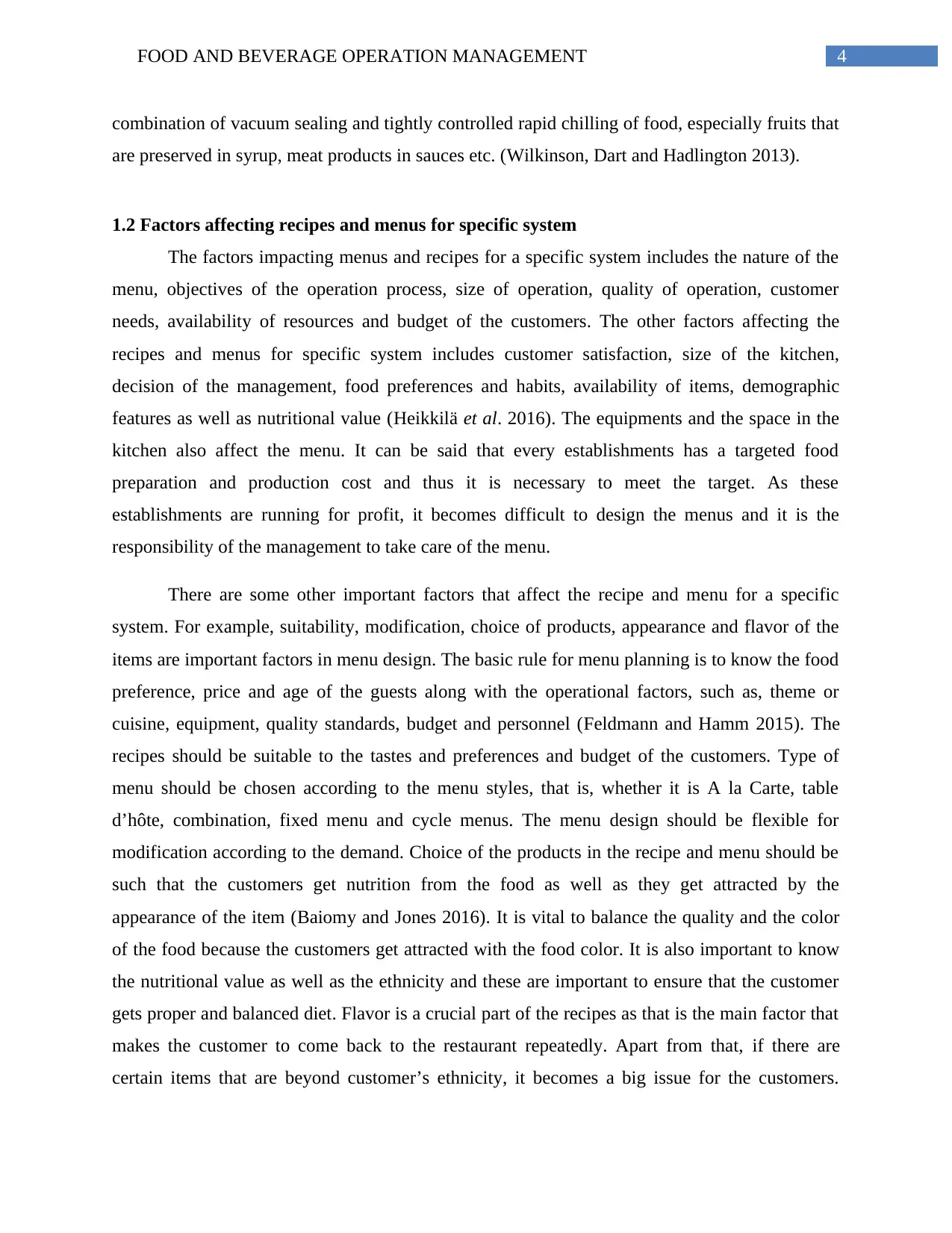
4FOOD AND BEVERAGE OPERATION MANAGEMENT
combination of vacuum sealing and tightly controlled rapid chilling of food, especially fruits that
are preserved in syrup, meat products in sauces etc. (Wilkinson, Dart and Hadlington 2013).
1.2 Factors affecting recipes and menus for specific system
The factors impacting menus and recipes for a specific system includes the nature of the
menu, objectives of the operation process, size of operation, quality of operation, customer
needs, availability of resources and budget of the customers. The other factors affecting the
recipes and menus for specific system includes customer satisfaction, size of the kitchen,
decision of the management, food preferences and habits, availability of items, demographic
features as well as nutritional value (Heikkilä et al. 2016). The equipments and the space in the
kitchen also affect the menu. It can be said that every establishments has a targeted food
preparation and production cost and thus it is necessary to meet the target. As these
establishments are running for profit, it becomes difficult to design the menus and it is the
responsibility of the management to take care of the menu.
There are some other important factors that affect the recipe and menu for a specific
system. For example, suitability, modification, choice of products, appearance and flavor of the
items are important factors in menu design. The basic rule for menu planning is to know the food
preference, price and age of the guests along with the operational factors, such as, theme or
cuisine, equipment, quality standards, budget and personnel (Feldmann and Hamm 2015). The
recipes should be suitable to the tastes and preferences and budget of the customers. Type of
menu should be chosen according to the menu styles, that is, whether it is A la Carte, table
d’hôte, combination, fixed menu and cycle menus. The menu design should be flexible for
modification according to the demand. Choice of the products in the recipe and menu should be
such that the customers get nutrition from the food as well as they get attracted by the
appearance of the item (Baiomy and Jones 2016). It is vital to balance the quality and the color
of the food because the customers get attracted with the food color. It is also important to know
the nutritional value as well as the ethnicity and these are important to ensure that the customer
gets proper and balanced diet. Flavor is a crucial part of the recipes as that is the main factor that
makes the customer to come back to the restaurant repeatedly. Apart from that, if there are
certain items that are beyond customer’s ethnicity, it becomes a big issue for the customers.
combination of vacuum sealing and tightly controlled rapid chilling of food, especially fruits that
are preserved in syrup, meat products in sauces etc. (Wilkinson, Dart and Hadlington 2013).
1.2 Factors affecting recipes and menus for specific system
The factors impacting menus and recipes for a specific system includes the nature of the
menu, objectives of the operation process, size of operation, quality of operation, customer
needs, availability of resources and budget of the customers. The other factors affecting the
recipes and menus for specific system includes customer satisfaction, size of the kitchen,
decision of the management, food preferences and habits, availability of items, demographic
features as well as nutritional value (Heikkilä et al. 2016). The equipments and the space in the
kitchen also affect the menu. It can be said that every establishments has a targeted food
preparation and production cost and thus it is necessary to meet the target. As these
establishments are running for profit, it becomes difficult to design the menus and it is the
responsibility of the management to take care of the menu.
There are some other important factors that affect the recipe and menu for a specific
system. For example, suitability, modification, choice of products, appearance and flavor of the
items are important factors in menu design. The basic rule for menu planning is to know the food
preference, price and age of the guests along with the operational factors, such as, theme or
cuisine, equipment, quality standards, budget and personnel (Feldmann and Hamm 2015). The
recipes should be suitable to the tastes and preferences and budget of the customers. Type of
menu should be chosen according to the menu styles, that is, whether it is A la Carte, table
d’hôte, combination, fixed menu and cycle menus. The menu design should be flexible for
modification according to the demand. Choice of the products in the recipe and menu should be
such that the customers get nutrition from the food as well as they get attracted by the
appearance of the item (Baiomy and Jones 2016). It is vital to balance the quality and the color
of the food because the customers get attracted with the food color. It is also important to know
the nutritional value as well as the ethnicity and these are important to ensure that the customer
gets proper and balanced diet. Flavor is a crucial part of the recipes as that is the main factor that
makes the customer to come back to the restaurant repeatedly. Apart from that, if there are
certain items that are beyond customer’s ethnicity, it becomes a big issue for the customers.
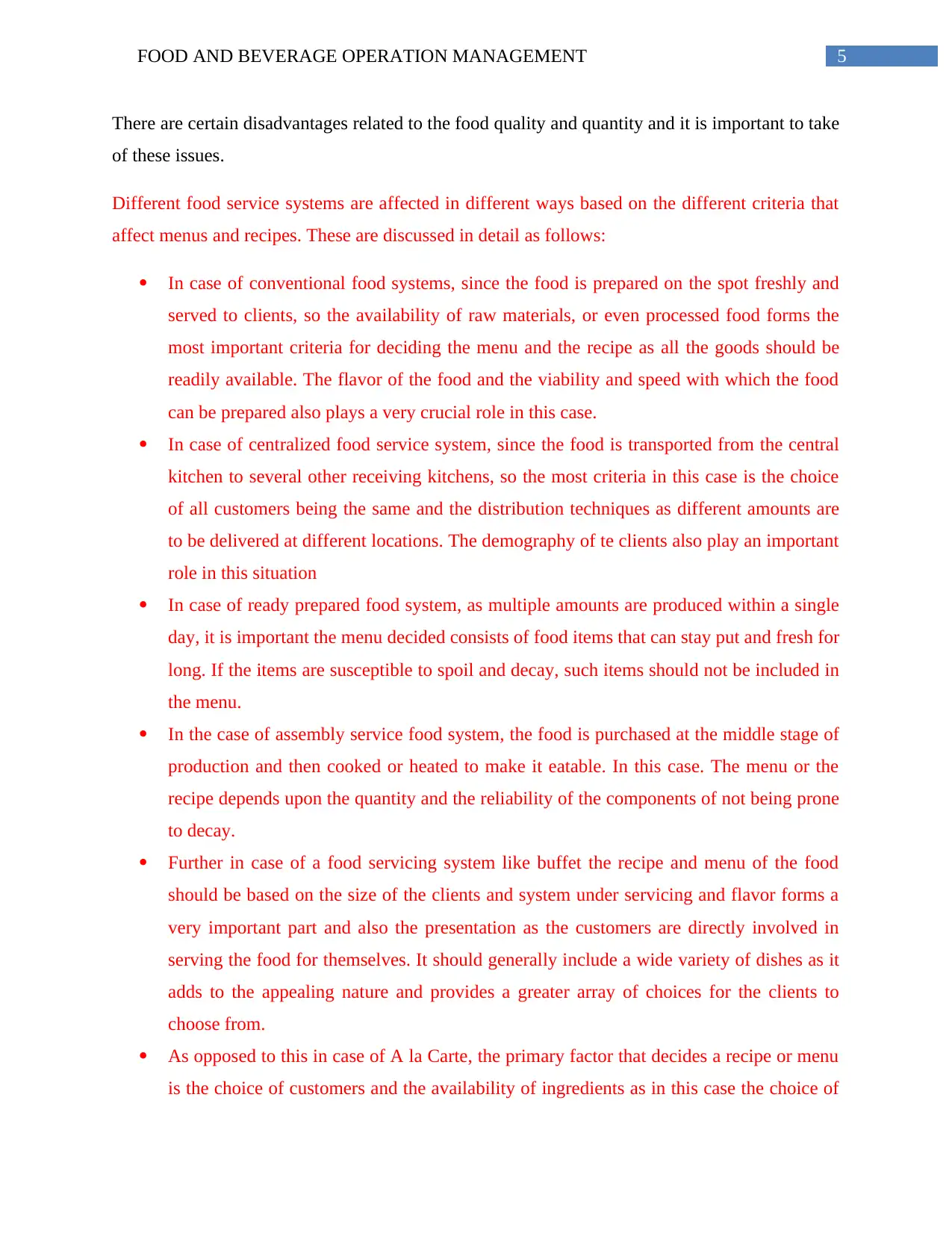
5FOOD AND BEVERAGE OPERATION MANAGEMENT
There are certain disadvantages related to the food quality and quantity and it is important to take
of these issues.
Different food service systems are affected in different ways based on the different criteria that
affect menus and recipes. These are discussed in detail as follows:
In case of conventional food systems, since the food is prepared on the spot freshly and
served to clients, so the availability of raw materials, or even processed food forms the
most important criteria for deciding the menu and the recipe as all the goods should be
readily available. The flavor of the food and the viability and speed with which the food
can be prepared also plays a very crucial role in this case.
In case of centralized food service system, since the food is transported from the central
kitchen to several other receiving kitchens, so the most criteria in this case is the choice
of all customers being the same and the distribution techniques as different amounts are
to be delivered at different locations. The demography of te clients also play an important
role in this situation
In case of ready prepared food system, as multiple amounts are produced within a single
day, it is important the menu decided consists of food items that can stay put and fresh for
long. If the items are susceptible to spoil and decay, such items should not be included in
the menu.
In the case of assembly service food system, the food is purchased at the middle stage of
production and then cooked or heated to make it eatable. In this case. The menu or the
recipe depends upon the quantity and the reliability of the components of not being prone
to decay.
Further in case of a food servicing system like buffet the recipe and menu of the food
should be based on the size of the clients and system under servicing and flavor forms a
very important part and also the presentation as the customers are directly involved in
serving the food for themselves. It should generally include a wide variety of dishes as it
adds to the appealing nature and provides a greater array of choices for the clients to
choose from.
As opposed to this in case of A la Carte, the primary factor that decides a recipe or menu
is the choice of customers and the availability of ingredients as in this case the choice of
There are certain disadvantages related to the food quality and quantity and it is important to take
of these issues.
Different food service systems are affected in different ways based on the different criteria that
affect menus and recipes. These are discussed in detail as follows:
In case of conventional food systems, since the food is prepared on the spot freshly and
served to clients, so the availability of raw materials, or even processed food forms the
most important criteria for deciding the menu and the recipe as all the goods should be
readily available. The flavor of the food and the viability and speed with which the food
can be prepared also plays a very crucial role in this case.
In case of centralized food service system, since the food is transported from the central
kitchen to several other receiving kitchens, so the most criteria in this case is the choice
of all customers being the same and the distribution techniques as different amounts are
to be delivered at different locations. The demography of te clients also play an important
role in this situation
In case of ready prepared food system, as multiple amounts are produced within a single
day, it is important the menu decided consists of food items that can stay put and fresh for
long. If the items are susceptible to spoil and decay, such items should not be included in
the menu.
In the case of assembly service food system, the food is purchased at the middle stage of
production and then cooked or heated to make it eatable. In this case. The menu or the
recipe depends upon the quantity and the reliability of the components of not being prone
to decay.
Further in case of a food servicing system like buffet the recipe and menu of the food
should be based on the size of the clients and system under servicing and flavor forms a
very important part and also the presentation as the customers are directly involved in
serving the food for themselves. It should generally include a wide variety of dishes as it
adds to the appealing nature and provides a greater array of choices for the clients to
choose from.
As opposed to this in case of A la Carte, the primary factor that decides a recipe or menu
is the choice of customers and the availability of ingredients as in this case the choice of
⊘ This is a preview!⊘
Do you want full access?
Subscribe today to unlock all pages.

Trusted by 1+ million students worldwide
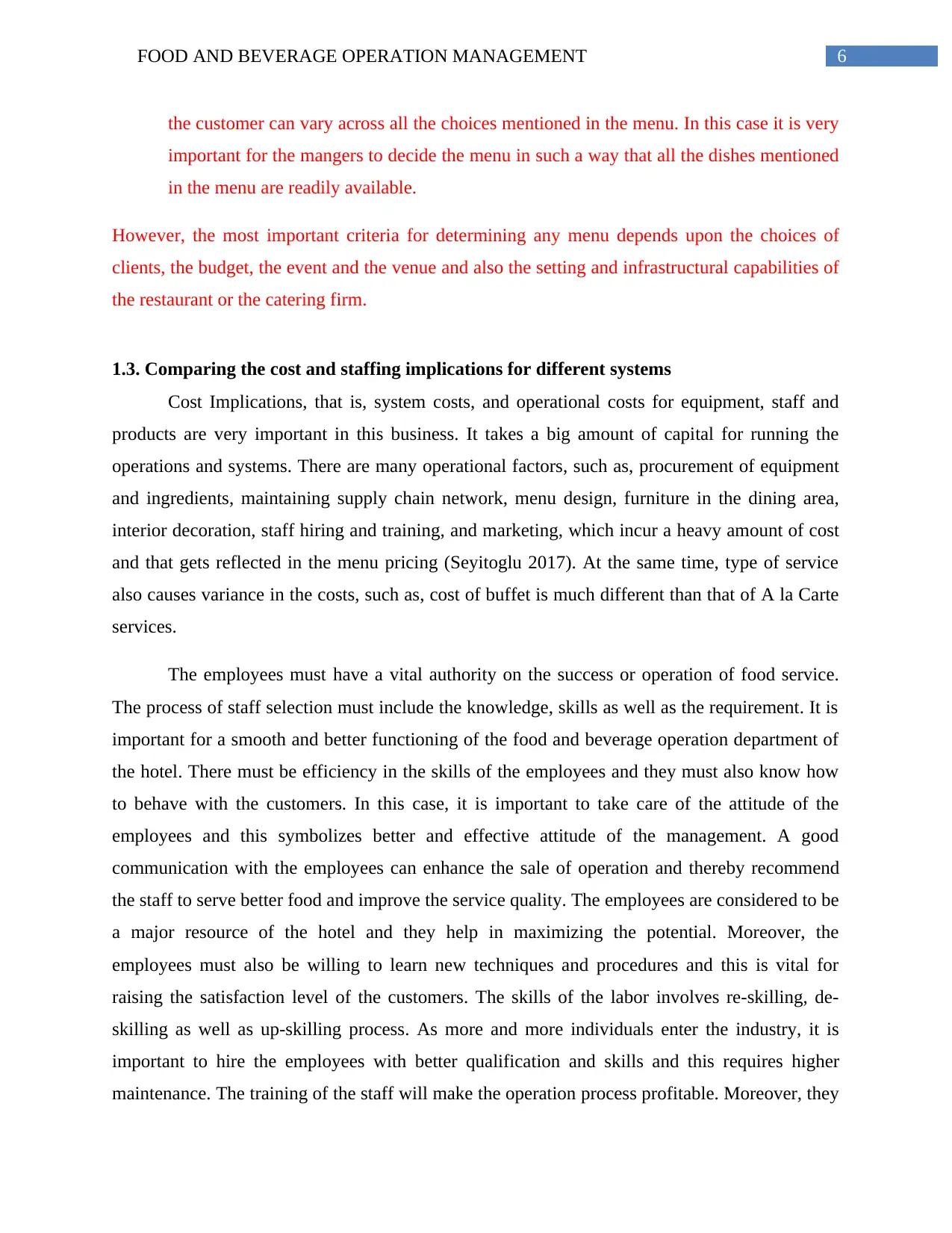
6FOOD AND BEVERAGE OPERATION MANAGEMENT
the customer can vary across all the choices mentioned in the menu. In this case it is very
important for the mangers to decide the menu in such a way that all the dishes mentioned
in the menu are readily available.
However, the most important criteria for determining any menu depends upon the choices of
clients, the budget, the event and the venue and also the setting and infrastructural capabilities of
the restaurant or the catering firm.
1.3. Comparing the cost and staffing implications for different systems
Cost Implications, that is, system costs, and operational costs for equipment, staff and
products are very important in this business. It takes a big amount of capital for running the
operations and systems. There are many operational factors, such as, procurement of equipment
and ingredients, maintaining supply chain network, menu design, furniture in the dining area,
interior decoration, staff hiring and training, and marketing, which incur a heavy amount of cost
and that gets reflected in the menu pricing (Seyitoglu 2017). At the same time, type of service
also causes variance in the costs, such as, cost of buffet is much different than that of A la Carte
services.
The employees must have a vital authority on the success or operation of food service.
The process of staff selection must include the knowledge, skills as well as the requirement. It is
important for a smooth and better functioning of the food and beverage operation department of
the hotel. There must be efficiency in the skills of the employees and they must also know how
to behave with the customers. In this case, it is important to take care of the attitude of the
employees and this symbolizes better and effective attitude of the management. A good
communication with the employees can enhance the sale of operation and thereby recommend
the staff to serve better food and improve the service quality. The employees are considered to be
a major resource of the hotel and they help in maximizing the potential. Moreover, the
employees must also be willing to learn new techniques and procedures and this is vital for
raising the satisfaction level of the customers. The skills of the labor involves re-skilling, de-
skilling as well as up-skilling process. As more and more individuals enter the industry, it is
important to hire the employees with better qualification and skills and this requires higher
maintenance. The training of the staff will make the operation process profitable. Moreover, they
the customer can vary across all the choices mentioned in the menu. In this case it is very
important for the mangers to decide the menu in such a way that all the dishes mentioned
in the menu are readily available.
However, the most important criteria for determining any menu depends upon the choices of
clients, the budget, the event and the venue and also the setting and infrastructural capabilities of
the restaurant or the catering firm.
1.3. Comparing the cost and staffing implications for different systems
Cost Implications, that is, system costs, and operational costs for equipment, staff and
products are very important in this business. It takes a big amount of capital for running the
operations and systems. There are many operational factors, such as, procurement of equipment
and ingredients, maintaining supply chain network, menu design, furniture in the dining area,
interior decoration, staff hiring and training, and marketing, which incur a heavy amount of cost
and that gets reflected in the menu pricing (Seyitoglu 2017). At the same time, type of service
also causes variance in the costs, such as, cost of buffet is much different than that of A la Carte
services.
The employees must have a vital authority on the success or operation of food service.
The process of staff selection must include the knowledge, skills as well as the requirement. It is
important for a smooth and better functioning of the food and beverage operation department of
the hotel. There must be efficiency in the skills of the employees and they must also know how
to behave with the customers. In this case, it is important to take care of the attitude of the
employees and this symbolizes better and effective attitude of the management. A good
communication with the employees can enhance the sale of operation and thereby recommend
the staff to serve better food and improve the service quality. The employees are considered to be
a major resource of the hotel and they help in maximizing the potential. Moreover, the
employees must also be willing to learn new techniques and procedures and this is vital for
raising the satisfaction level of the customers. The skills of the labor involves re-skilling, de-
skilling as well as up-skilling process. As more and more individuals enter the industry, it is
important to hire the employees with better qualification and skills and this requires higher
maintenance. The training of the staff will make the operation process profitable. Moreover, they
Paraphrase This Document
Need a fresh take? Get an instant paraphrase of this document with our AI Paraphraser
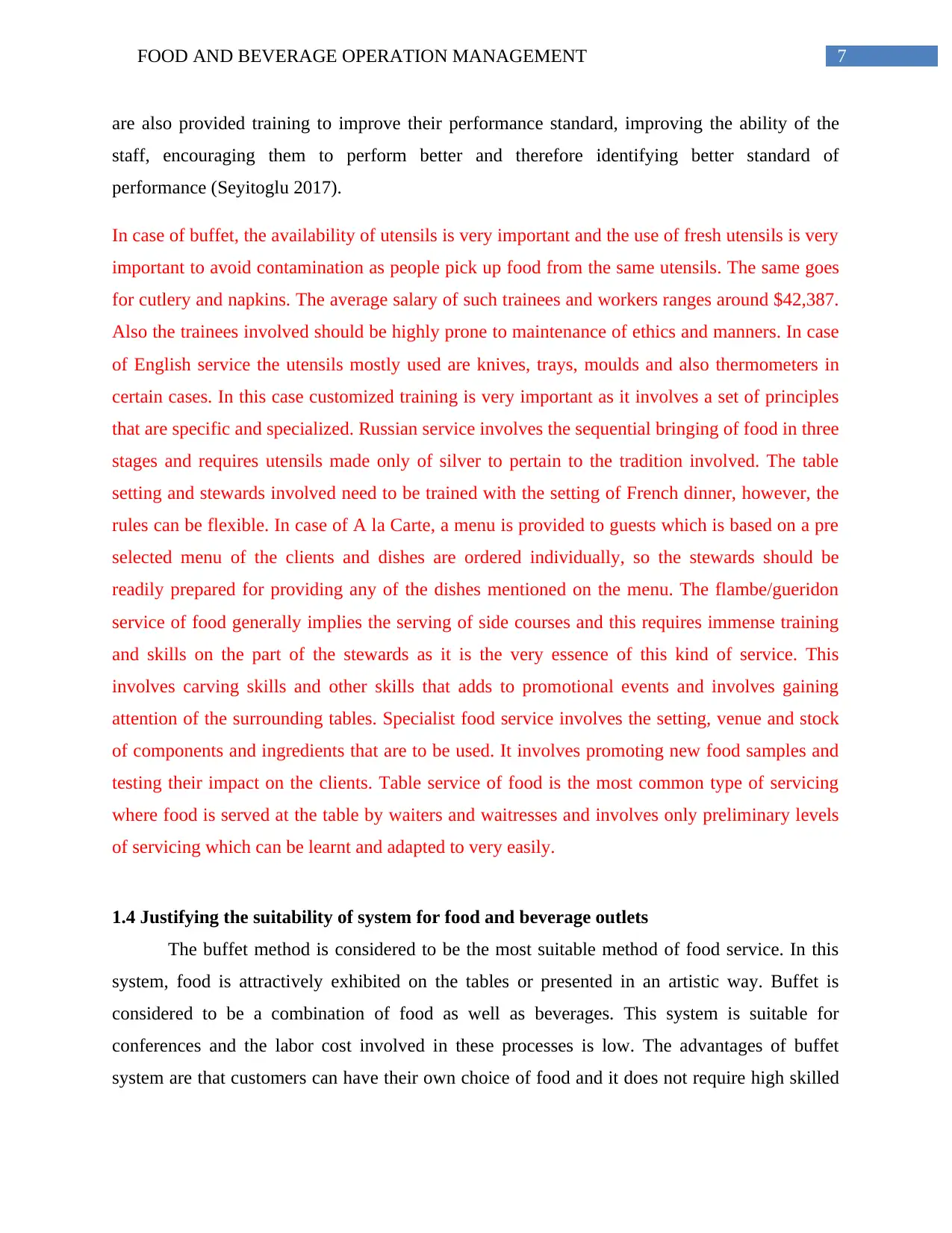
7FOOD AND BEVERAGE OPERATION MANAGEMENT
are also provided training to improve their performance standard, improving the ability of the
staff, encouraging them to perform better and therefore identifying better standard of
performance (Seyitoglu 2017).
In case of buffet, the availability of utensils is very important and the use of fresh utensils is very
important to avoid contamination as people pick up food from the same utensils. The same goes
for cutlery and napkins. The average salary of such trainees and workers ranges around $42,387.
Also the trainees involved should be highly prone to maintenance of ethics and manners. In case
of English service the utensils mostly used are knives, trays, moulds and also thermometers in
certain cases. In this case customized training is very important as it involves a set of principles
that are specific and specialized. Russian service involves the sequential bringing of food in three
stages and requires utensils made only of silver to pertain to the tradition involved. The table
setting and stewards involved need to be trained with the setting of French dinner, however, the
rules can be flexible. In case of A la Carte, a menu is provided to guests which is based on a pre
selected menu of the clients and dishes are ordered individually, so the stewards should be
readily prepared for providing any of the dishes mentioned on the menu. The flambe/gueridon
service of food generally implies the serving of side courses and this requires immense training
and skills on the part of the stewards as it is the very essence of this kind of service. This
involves carving skills and other skills that adds to promotional events and involves gaining
attention of the surrounding tables. Specialist food service involves the setting, venue and stock
of components and ingredients that are to be used. It involves promoting new food samples and
testing their impact on the clients. Table service of food is the most common type of servicing
where food is served at the table by waiters and waitresses and involves only preliminary levels
of servicing which can be learnt and adapted to very easily.
1.4 Justifying the suitability of system for food and beverage outlets
The buffet method is considered to be the most suitable method of food service. In this
system, food is attractively exhibited on the tables or presented in an artistic way. Buffet is
considered to be a combination of food as well as beverages. This system is suitable for
conferences and the labor cost involved in these processes is low. The advantages of buffet
system are that customers can have their own choice of food and it does not require high skilled
are also provided training to improve their performance standard, improving the ability of the
staff, encouraging them to perform better and therefore identifying better standard of
performance (Seyitoglu 2017).
In case of buffet, the availability of utensils is very important and the use of fresh utensils is very
important to avoid contamination as people pick up food from the same utensils. The same goes
for cutlery and napkins. The average salary of such trainees and workers ranges around $42,387.
Also the trainees involved should be highly prone to maintenance of ethics and manners. In case
of English service the utensils mostly used are knives, trays, moulds and also thermometers in
certain cases. In this case customized training is very important as it involves a set of principles
that are specific and specialized. Russian service involves the sequential bringing of food in three
stages and requires utensils made only of silver to pertain to the tradition involved. The table
setting and stewards involved need to be trained with the setting of French dinner, however, the
rules can be flexible. In case of A la Carte, a menu is provided to guests which is based on a pre
selected menu of the clients and dishes are ordered individually, so the stewards should be
readily prepared for providing any of the dishes mentioned on the menu. The flambe/gueridon
service of food generally implies the serving of side courses and this requires immense training
and skills on the part of the stewards as it is the very essence of this kind of service. This
involves carving skills and other skills that adds to promotional events and involves gaining
attention of the surrounding tables. Specialist food service involves the setting, venue and stock
of components and ingredients that are to be used. It involves promoting new food samples and
testing their impact on the clients. Table service of food is the most common type of servicing
where food is served at the table by waiters and waitresses and involves only preliminary levels
of servicing which can be learnt and adapted to very easily.
1.4 Justifying the suitability of system for food and beverage outlets
The buffet method is considered to be the most suitable method of food service. In this
system, food is attractively exhibited on the tables or presented in an artistic way. Buffet is
considered to be a combination of food as well as beverages. This system is suitable for
conferences and the labor cost involved in these processes is low. The advantages of buffet
system are that customers can have their own choice of food and it does not require high skilled
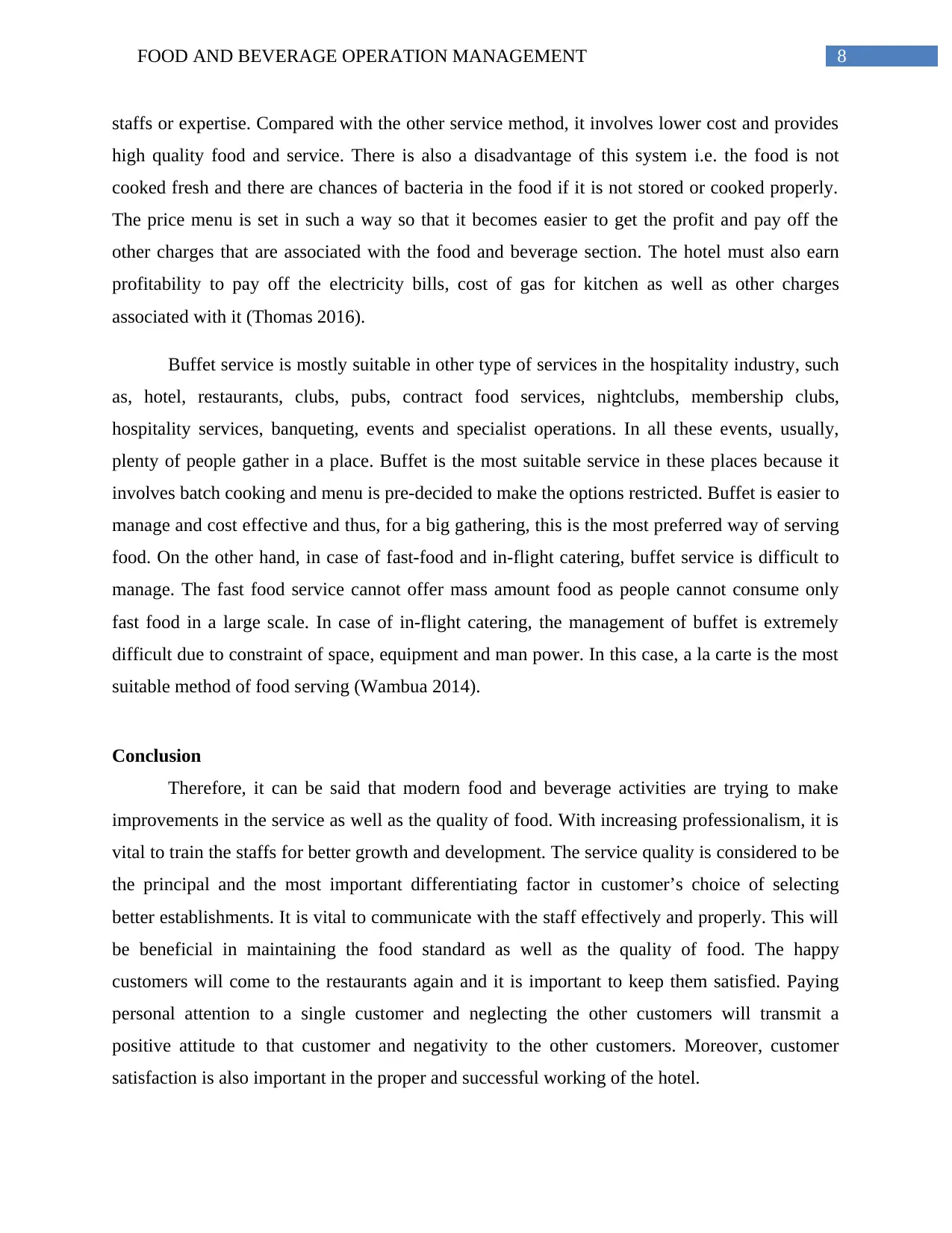
8FOOD AND BEVERAGE OPERATION MANAGEMENT
staffs or expertise. Compared with the other service method, it involves lower cost and provides
high quality food and service. There is also a disadvantage of this system i.e. the food is not
cooked fresh and there are chances of bacteria in the food if it is not stored or cooked properly.
The price menu is set in such a way so that it becomes easier to get the profit and pay off the
other charges that are associated with the food and beverage section. The hotel must also earn
profitability to pay off the electricity bills, cost of gas for kitchen as well as other charges
associated with it (Thomas 2016).
Buffet service is mostly suitable in other type of services in the hospitality industry, such
as, hotel, restaurants, clubs, pubs, contract food services, nightclubs, membership clubs,
hospitality services, banqueting, events and specialist operations. In all these events, usually,
plenty of people gather in a place. Buffet is the most suitable service in these places because it
involves batch cooking and menu is pre-decided to make the options restricted. Buffet is easier to
manage and cost effective and thus, for a big gathering, this is the most preferred way of serving
food. On the other hand, in case of fast-food and in-flight catering, buffet service is difficult to
manage. The fast food service cannot offer mass amount food as people cannot consume only
fast food in a large scale. In case of in-flight catering, the management of buffet is extremely
difficult due to constraint of space, equipment and man power. In this case, a la carte is the most
suitable method of food serving (Wambua 2014).
Conclusion
Therefore, it can be said that modern food and beverage activities are trying to make
improvements in the service as well as the quality of food. With increasing professionalism, it is
vital to train the staffs for better growth and development. The service quality is considered to be
the principal and the most important differentiating factor in customer’s choice of selecting
better establishments. It is vital to communicate with the staff effectively and properly. This will
be beneficial in maintaining the food standard as well as the quality of food. The happy
customers will come to the restaurants again and it is important to keep them satisfied. Paying
personal attention to a single customer and neglecting the other customers will transmit a
positive attitude to that customer and negativity to the other customers. Moreover, customer
satisfaction is also important in the proper and successful working of the hotel.
staffs or expertise. Compared with the other service method, it involves lower cost and provides
high quality food and service. There is also a disadvantage of this system i.e. the food is not
cooked fresh and there are chances of bacteria in the food if it is not stored or cooked properly.
The price menu is set in such a way so that it becomes easier to get the profit and pay off the
other charges that are associated with the food and beverage section. The hotel must also earn
profitability to pay off the electricity bills, cost of gas for kitchen as well as other charges
associated with it (Thomas 2016).
Buffet service is mostly suitable in other type of services in the hospitality industry, such
as, hotel, restaurants, clubs, pubs, contract food services, nightclubs, membership clubs,
hospitality services, banqueting, events and specialist operations. In all these events, usually,
plenty of people gather in a place. Buffet is the most suitable service in these places because it
involves batch cooking and menu is pre-decided to make the options restricted. Buffet is easier to
manage and cost effective and thus, for a big gathering, this is the most preferred way of serving
food. On the other hand, in case of fast-food and in-flight catering, buffet service is difficult to
manage. The fast food service cannot offer mass amount food as people cannot consume only
fast food in a large scale. In case of in-flight catering, the management of buffet is extremely
difficult due to constraint of space, equipment and man power. In this case, a la carte is the most
suitable method of food serving (Wambua 2014).
Conclusion
Therefore, it can be said that modern food and beverage activities are trying to make
improvements in the service as well as the quality of food. With increasing professionalism, it is
vital to train the staffs for better growth and development. The service quality is considered to be
the principal and the most important differentiating factor in customer’s choice of selecting
better establishments. It is vital to communicate with the staff effectively and properly. This will
be beneficial in maintaining the food standard as well as the quality of food. The happy
customers will come to the restaurants again and it is important to keep them satisfied. Paying
personal attention to a single customer and neglecting the other customers will transmit a
positive attitude to that customer and negativity to the other customers. Moreover, customer
satisfaction is also important in the proper and successful working of the hotel.
⊘ This is a preview!⊘
Do you want full access?
Subscribe today to unlock all pages.

Trusted by 1+ million students worldwide
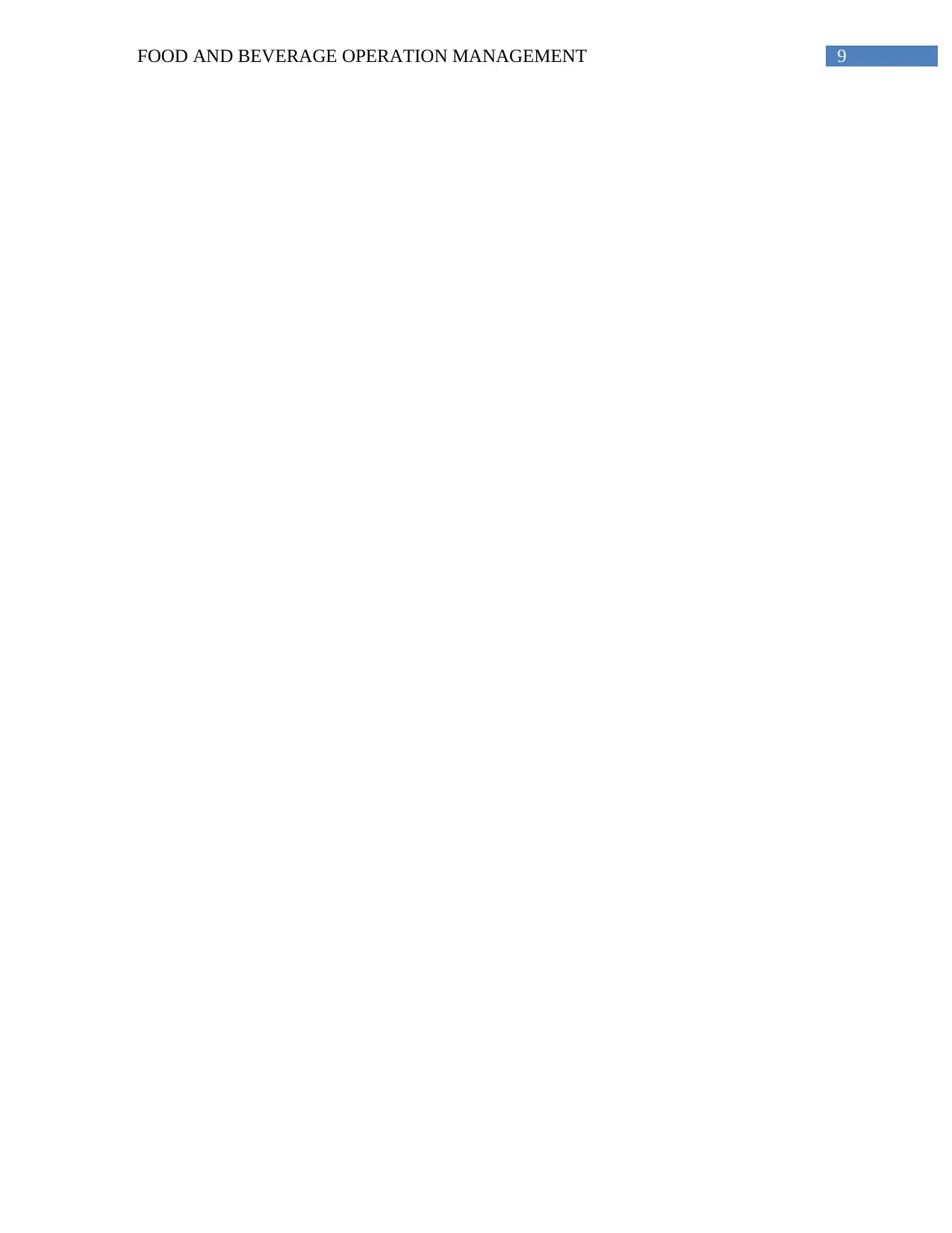
9FOOD AND BEVERAGE OPERATION MANAGEMENT
Paraphrase This Document
Need a fresh take? Get an instant paraphrase of this document with our AI Paraphraser
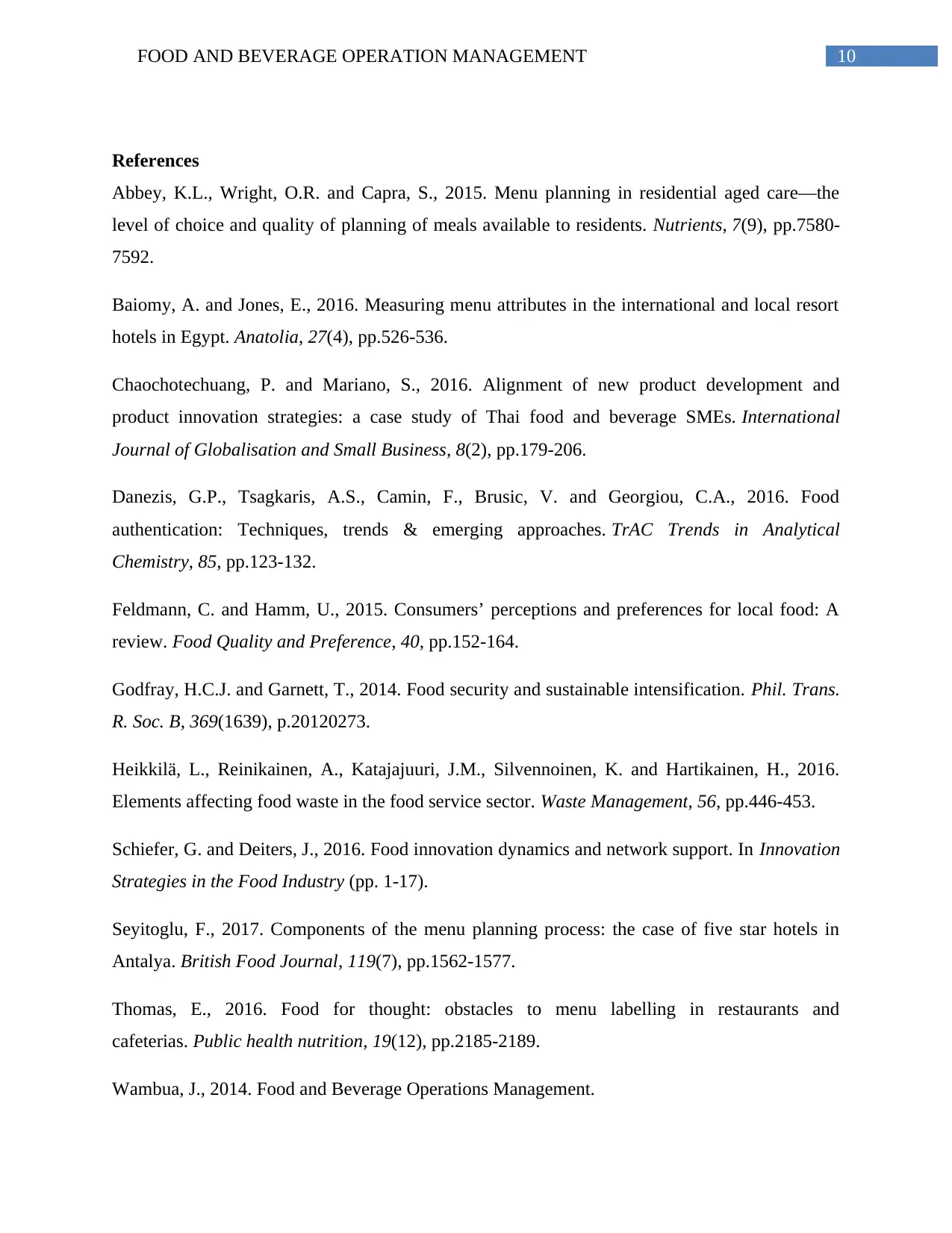
10FOOD AND BEVERAGE OPERATION MANAGEMENT
References
Abbey, K.L., Wright, O.R. and Capra, S., 2015. Menu planning in residential aged care—the
level of choice and quality of planning of meals available to residents. Nutrients, 7(9), pp.7580-
7592.
Baiomy, A. and Jones, E., 2016. Measuring menu attributes in the international and local resort
hotels in Egypt. Anatolia, 27(4), pp.526-536.
Chaochotechuang, P. and Mariano, S., 2016. Alignment of new product development and
product innovation strategies: a case study of Thai food and beverage SMEs. International
Journal of Globalisation and Small Business, 8(2), pp.179-206.
Danezis, G.P., Tsagkaris, A.S., Camin, F., Brusic, V. and Georgiou, C.A., 2016. Food
authentication: Techniques, trends & emerging approaches. TrAC Trends in Analytical
Chemistry, 85, pp.123-132.
Feldmann, C. and Hamm, U., 2015. Consumers’ perceptions and preferences for local food: A
review. Food Quality and Preference, 40, pp.152-164.
Godfray, H.C.J. and Garnett, T., 2014. Food security and sustainable intensification. Phil. Trans.
R. Soc. B, 369(1639), p.20120273.
Heikkilä, L., Reinikainen, A., Katajajuuri, J.M., Silvennoinen, K. and Hartikainen, H., 2016.
Elements affecting food waste in the food service sector. Waste Management, 56, pp.446-453.
Schiefer, G. and Deiters, J., 2016. Food innovation dynamics and network support. In Innovation
Strategies in the Food Industry (pp. 1-17).
Seyitoglu, F., 2017. Components of the menu planning process: the case of five star hotels in
Antalya. British Food Journal, 119(7), pp.1562-1577.
Thomas, E., 2016. Food for thought: obstacles to menu labelling in restaurants and
cafeterias. Public health nutrition, 19(12), pp.2185-2189.
Wambua, J., 2014. Food and Beverage Operations Management.
References
Abbey, K.L., Wright, O.R. and Capra, S., 2015. Menu planning in residential aged care—the
level of choice and quality of planning of meals available to residents. Nutrients, 7(9), pp.7580-
7592.
Baiomy, A. and Jones, E., 2016. Measuring menu attributes in the international and local resort
hotels in Egypt. Anatolia, 27(4), pp.526-536.
Chaochotechuang, P. and Mariano, S., 2016. Alignment of new product development and
product innovation strategies: a case study of Thai food and beverage SMEs. International
Journal of Globalisation and Small Business, 8(2), pp.179-206.
Danezis, G.P., Tsagkaris, A.S., Camin, F., Brusic, V. and Georgiou, C.A., 2016. Food
authentication: Techniques, trends & emerging approaches. TrAC Trends in Analytical
Chemistry, 85, pp.123-132.
Feldmann, C. and Hamm, U., 2015. Consumers’ perceptions and preferences for local food: A
review. Food Quality and Preference, 40, pp.152-164.
Godfray, H.C.J. and Garnett, T., 2014. Food security and sustainable intensification. Phil. Trans.
R. Soc. B, 369(1639), p.20120273.
Heikkilä, L., Reinikainen, A., Katajajuuri, J.M., Silvennoinen, K. and Hartikainen, H., 2016.
Elements affecting food waste in the food service sector. Waste Management, 56, pp.446-453.
Schiefer, G. and Deiters, J., 2016. Food innovation dynamics and network support. In Innovation
Strategies in the Food Industry (pp. 1-17).
Seyitoglu, F., 2017. Components of the menu planning process: the case of five star hotels in
Antalya. British Food Journal, 119(7), pp.1562-1577.
Thomas, E., 2016. Food for thought: obstacles to menu labelling in restaurants and
cafeterias. Public health nutrition, 19(12), pp.2185-2189.
Wambua, J., 2014. Food and Beverage Operations Management.
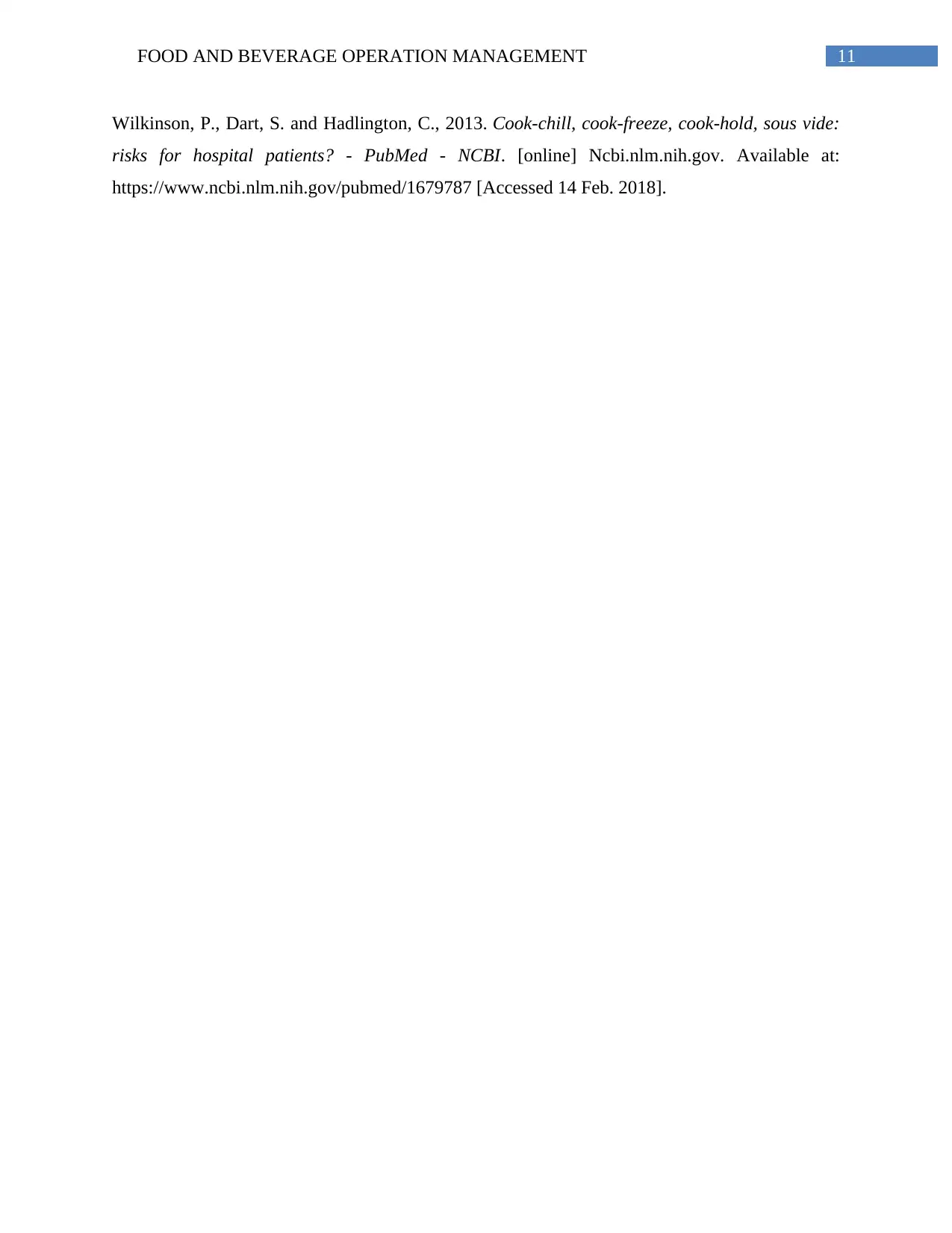
11FOOD AND BEVERAGE OPERATION MANAGEMENT
Wilkinson, P., Dart, S. and Hadlington, C., 2013. Cook-chill, cook-freeze, cook-hold, sous vide:
risks for hospital patients? - PubMed - NCBI. [online] Ncbi.nlm.nih.gov. Available at:
https://www.ncbi.nlm.nih.gov/pubmed/1679787 [Accessed 14 Feb. 2018].
Wilkinson, P., Dart, S. and Hadlington, C., 2013. Cook-chill, cook-freeze, cook-hold, sous vide:
risks for hospital patients? - PubMed - NCBI. [online] Ncbi.nlm.nih.gov. Available at:
https://www.ncbi.nlm.nih.gov/pubmed/1679787 [Accessed 14 Feb. 2018].
⊘ This is a preview!⊘
Do you want full access?
Subscribe today to unlock all pages.

Trusted by 1+ million students worldwide
1 out of 12
Related Documents
Your All-in-One AI-Powered Toolkit for Academic Success.
+13062052269
info@desklib.com
Available 24*7 on WhatsApp / Email
![[object Object]](/_next/static/media/star-bottom.7253800d.svg)
Unlock your academic potential
Copyright © 2020–2025 A2Z Services. All Rights Reserved. Developed and managed by ZUCOL.




